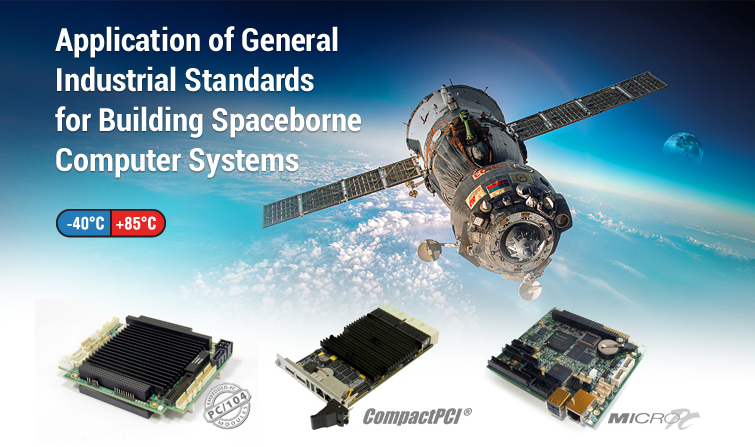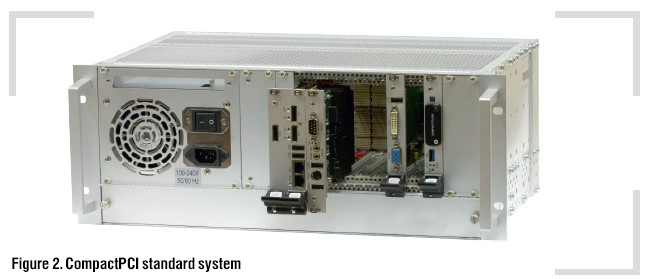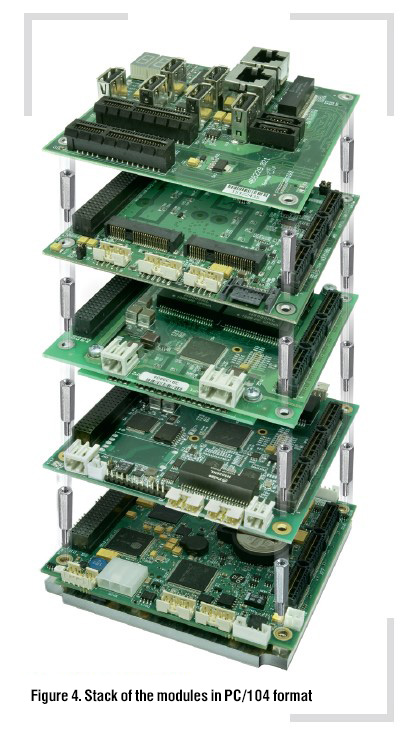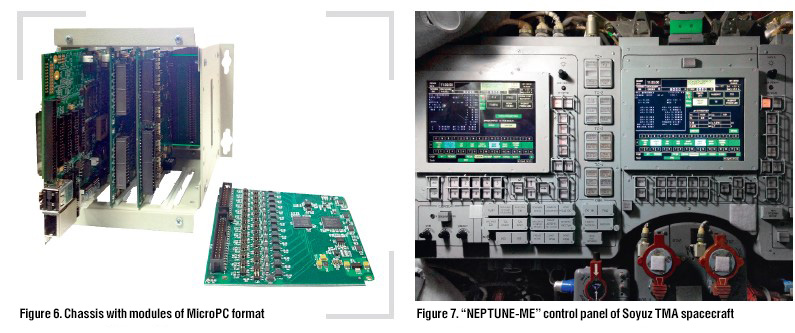
News
Application of General Industrial Standards for Building Spaceborne Computer Systems

Due to the recently increased demands for cost reduction in manufacturing of aerospace systems, the developers made heavy use of the COTS (Commercial Off-The-Shelf) technology. In order to build special-purpose systems this technology applies the approach where industrial computing modules are used, while crates, racks, switching units and cables have special design and ensure the required operating conditions (e.g. resistance to climatic, vibration, acoustic and other effects). The COTS-technology uses off-the-shelf open-type hardware and software technologies that were previously widely tested and/or standardized on the market of general industrial applications. The COTS concept initially emerged as an initiative of the United States Department of Defense and defense establishments of several other western countries wishing to cut their expenditures through the reduction of the number of expensive unique solutions and technologies.
The general trend in building systems based on standardized COTS components has also got into the space industry. This was encouraged by an extremely rapid pace of space exploration, increasing complexity of the tasks solved, requirements for the reduction of system development and modernization terms, improving their speed and reliability. Today there is a large number of manned and unmanned spacecrafts of various countries in outer space. This has turned into a powerful industry sector related to research, production of new materials and other vital tasks.
Effects of Radiation on Microchips
In terms of particle volume, the space radiation composition is as follows: about 90% are protons (i.e. hydrogen ions), about 7% are helium nuclei (alpha particles), ~1% are heavier atoms and ~1% – are electrons. The stars, including the Sun, nuclei of the galaxies, the Milky Way, are not only powerful sources of visible light, but also the sources of X-ray and gamma-ray emissions. During the solar flares, radiation emitted by the Sun is increased by 1000–1 000 000 times which could be a serious problem for future humans and for current space vehicles beyond the Earth’s magnetosphere. There are two belts of charged particles around the Earth – the so called Van Allen radiation belts: at a height of ~4000 km made of protons and at a height ~17 000 km made of electrons. The particles there are moving along the closed orbits, captured by the Earth’s magnetic field. There is also a Brazilian Magnetic Anomaly, where the inner radiation belt comes closest to the Earth’s surface, dipping down to an altitude of 200 km. When gamma- and X-rays (including secondary radiation received due to the collision of electrons with spaceship’s enclosure) go through the microchip, the charge starts to gradually accumulate in transistors’ gate insulator, which correspondingly results in a slow change of transistor parameters – transistor threshold voltage and leak current. A common digital integrated circuit could stop its fault-free operation already after 5000 rad (by the way, when it comes to human organism, such threshold is reached already after 500–1000 rad). In Low Earth Orbit (LEO) of 300–500 km (where all human spaceflights take place), the annual dose could be 100 rad and less, this means that the dose accumulated over a period of 10 years would be tolerable to the standard microchips. On the other hand, in High Earth Orbits (HEO) >1000 km the annual dose could be 10 000–20 000 rad and standard microchips would accumulate lethal dose in a matter of months. The biggest problem of space electronics is the collision with heavy charged particles – these are protons, alpha-particles and high energy ions. The heavy charged particles have high energy and they “pierce through” the microchip (together with satellite’s enclosure) and leaving behind the “trail” of the charge. This may cause program errors at best (0 becomes 1 or vice versa), or thyristor latching – in the worst case scenario. The latched chip is short-circuited to the ground, and it could pass through a very strong current, which could burn microchip as a result. If you are on time and switch off and connect prior to the burning, the entire system will be operating as per usual. The heavy charged particles in the outer space, having an effect on the integrated circuits (IC), could lead to distortions of separate data or program bits. Intensity of the failures depends on the type of memory used, orbit parameters and Sun activity.
The latching problem can be solved in several ways.
- Monitor the consumed current and quickly turn off\on the power switch.
- Use SOS (Silicon on sapphire, more generally – SOI or Silicon on insulator) microcircuits, which excludes generation of bipolar parasitic transistors and latching. Nevertheless, there could be program errors. The SOS plates are rather expensive, they are hard to process and have a limited area of application in the civilian sector. Therefore, their manufacturing is expensive too. Today SOI plates are generally used in most cases in their standard form – using oxide as a dielectric material.
- Use of the so called Triple-well process – it also significantly reduces the possibility of microcircuit latching due to additional insulation by p–n junction transistors, but requires no particular plates or equipment which makes production much cheaper than the one of the SOS, as a result.
In CIS countries, the SOS technology is used more often; the Western developers, on the contrary, as much as possible use a standard silicon with the triple-well (in order to combine with commercial products and reduce the costs), however the SOS/SOI are used too, if necessary.
In case of any distortions of memory contents in space vehicle’s equipment or improper operation of logics due to the heavy charged particles, this issue can be solved by proper architecture tools, e.g.:
- majority logic, when we connect 3 copies of each required unit at a distance of each other – in this case 2 correct answers will "neutralize" the incorrect one, using more error-resistant memory cells (out of 10 transistors instead of the usual 6);
- using the codes for correction of errors in memory, cache and registers. However, it is impossible to completely eliminate the errors, since the heavy charged particles (more specifically, an entire group of secondary particles) may pass exactly along the chip and some of the chip components might operate with errors. In this case, we need a highly reliable system including several independent computers and their proper programming.
As a result, the use of the standard microcircuits in space is limited by latching effect and would be available in low orbits, at best. Use in high orbits and in outer space requires special-purpose radiation-resistant microcircuits, since there we have no protection of the Earth's magnetic field, unless you’re using a meter-thick lead plate that will protect you against the highest-energy particles of cosmic radiation. The application areas of the COTS-technology should be well-defined and their misuse could lead to negative results.
.jpg)
Examples of Using the COTS-Technology in Space
The growing popularity of satellites manufactured in accordance with the CubeSat standard is illustrative of the use of the COTS-technologies and industrial electronic component base in space. The CubeSat is the format of small (ultra-small) artificial Earth satellites designed for space exploration, having a volume of 1 liter and a weight of no more than 1.33 kg or slightly higher volume and weight (Fig. 1).
These satellites usually use the CubeSat chassis-frame and standard purchased complementary components - COTS-electronics and other nodes. The CubeSat specifications were developed in 1999 by the California Polytechnic State University (Cal Poly) and Stanford University to simplify the creation of ultra-small satellites. The CubeSat specification includes standardized dimensions and architecture. All CubeSats are subdivided into sizes 1U (10x10x10 cm), 2U (10x10x20 cm), 3U (10x10x30 cm) etc.
The CubeSat standard does not limit imagination of the developers and engineering approaches to spacecraft building. There are no generally accepted assembly instructions, i.e. universal standards describing information, mechanical or electrical interfaces.
There are recommendations on the conformity of the dimensions of electronic boards to the form factor PC / 104, on some of the approaches to pinout of contacts, on data buses and supply rails, however the particular implementation for each developer can be individual.
The CubeSat satellites are created with the used of industrial electronics, i.e. the one that is designed for application on Earth and not in space. Nevertheless, the capabilities of modern chips enable using them under seemingly unacceptable conditions. They may be non-durable, but ensure equipment operation up to a year, and even several times more.
Other COTS Standards
CompactPCI
Systems based on the Compact-PCI standard have a mechanicals, which allow to install CPU and peripheral modules into a passive backplane with the standard-defined interconnects of data exchange between the system modules. The design characteristics, types and topologies of the interconnects, used are well-documented in the relevant standard developed by a consortium of international companies under the authority of PICMG (www.picmg.org). Design example is shown in Figure 2.

The systems are built in accordance with the Eurocard 3U, 6U standard format.
The main advantages of the CompactPCI standard are:
- Possibility to build multiprocessor heterogeneous computing systems;
- High shock and vibration resistance;
- Efficient cooling;
- Hot-swap support;
- Redundancy support;
- Application of standard chassis of different manufacturers.
A bright example of reliability of the systems implemented in accordance with the CompactPCI standard is the control system of the Mars exploration rover “Opportunity”, which is managed by two computers based on the CompactPCI standard.
The Opportunity rover landed on Mars on January 24, 2004 and is still functioning.
The core of the control system is a single-board computer RAD6000 (manufactured by BAE Systems), built in the format of CompactPCI 6U version 2.0. The RAD6000 is a radiation-resistant single-board computer based on the RISC-processor, manufactured by IBM (later this division became the part of BAE Systems). The computer has a maximum clock speed of 33 MHz and a speed of about 35 MIPS.
The board has 128 MB of RAM with ECC. This computer is usually equipped with OS VxWorks. The processor frequency can be set to 2.5 MHz, 5 MHz, 10 MHz or 20 MHz.
.jpg)
Today, the PICMG workgroup has started the development of the new Space CompactPCI Serial specification, which considers the specific requirements for application in space systems. The developed specification excludes some of the unclaimed functions in order to make the standard more compatible. At the same time, new features were added to optimize the standard Space CompactPCI Serial for space applications. The developed specification is added with two main innovations: use of the "double star" architecture and intelligent power management system. Furthermore, in addition to the Ethernet and PCI Express, it is possible to use other serial interfaces, such as SpaceWire, SpaceFibre, TT-Ethernet and rapid I/O, for interaction of the cards within the system.
The basic CompactPCI Serial specification defines a star topology for inter-module interaction. When it comes to the the Space CompactPCI Serial specification, symmetric duplication of interconnects is added. Therefore, the failure of one CPU does not affect the system functionality as a whole. A high degree of availability is very important in space, because, for example, you can’t simply replace the CPU module installed in the satellite in orbit. In addition to the system slot (A) on the left side of the system, the second system slot (B) is located on the right side of it, duplicating all inter-module links (Figure 3). All the seven peripheral slots are connected to both system ones that are also interconnected. These connections form a full-mesh or fully meshed interconnectivity network. The full-mesh network is not limited to any particular protocol and for physical interaction it can use, for example, the following standards: EtherNet, SpawnWire, TTEthner, Ethere-Spa, etc. Alongside with the Full Mesh network, the both system slots can be connected to any peripheral module via eight differential pairs. These links can also use any protocol, depending on the application and design of the modules. This architecture is called "double star" architecture and is designed for the use in highly-reliable solutions with a high availability degree. As a result, the Ethernet-based Full Mesh network is used alongside, as well as the "double star" architecture via PCI Express or any other serial protocol.
In addition to the inter-modular interaction innovation, the Space CompactPCI Serial specification determines the availability of a service connector through which the modules can be managed and configured over the control bus. Service connector, as well as those already available in the Standard CompactPCI Serial, supports the "hot swap" technology that enables you to replace the module without turning off the system power. The Space CompactPCI Serial provides the ability of building systems with conduction heatsink. In such a system, the modules are placed with a pitch of 5HP (25,4 mm). The CompactPCI Serial boards with conduction-cooled heatsink are wider than air-cooled (4HP wide), since they are built on the basis of a convection module enclosed in a metal enclosure, which significantly reduces the module production cost and, as a result, reduces the cost price. Today, the experts of the PICMG workgroup are working on a special-purpose backplane for Space CompactPCI Serial. High-speed connectors of the existing backplanes provide a bandwidth of up to 12.5 Gb/s in differential pair. The aggregate bandwidth of the Full Mesh network is 400 Gb/s, plus the double star interconnect also supports a bandwidth of up to 1Tb/s. Infrastructure signals provide a convenient and flexible control system. In addition to the I2C bus, CAN bus support is ensured. Power supply is 12 V. As an option, it is possible to use a redundant voltage of 5 V for power saving and sleep modes. Supports intelligent power management system that provides ability to disconnect and connect power to each slot on a stand-alone basis. Harsh operating conditions in outer space, especially vacuum, impose specific requirements on connectors. Their material must not be inflammable and must not evolve hazardous substances. The tests carried out have already confirmed the suitability of the selected connectors for the SpaseCompass PSI Serial. On the other hand, many requirements for mechanical and climatic effects, for example, resistance to single-event errors (self-reparable failure), are not described in the standard specification and are defined by the terms of reference for the system or modules being developed. The workgroup finishes working on the specification and plans to present it for the PICMG consortium for consideration in the 2-3 quarter of 2017.
PC/104
The PC/104 form-factor was adopted in 1992 in response to the requirements for reduction in overall dimensions and power consumption for computer systems. Each of these objectives was achieved without reducing hardware and software compatibility with the popular computer standards. PC/104 specification offers full architecture, hardware and software compatibility with computer standards in compact boards with sizes 3,6 x 3,8 (91.44x96.52 mm). The name of the standard is associated with the use of a 104-pin ISA bus located at the bottom of the board (Figure 4).

PC / 104 standards describe the modular principle of building compact embedded systems in the form of a stack of boards connected to each other. These standards have proved to be effective among the developers of compact on-board computer systems. Many engineers choose PC/104 because of the advantages provided by a low weight and size of such devices, the mechanical reliability of the connectors and the entire structure are also attractive. The PC / 104 family includes 5 specifications and describes the exchange of data between modules over 16 bit ISA parallel buses, PCI 32 bits and using PCI Express serial interconnects, USB 2.0 and SATA. In addition to the most compact size of 90x96 mm, the standards family includes EPIC and EBX form factors.
One example of the application is the use of PC/104 modules for building equipment for the space experiment called "Terminator". As part of this space experiment, observations were made in the visible and near infrared ranges of the spectrum of layered formations at a height of the upper mesosphere - lower thermosphere, in the vicinity of the solar terminator. For this space experiment, the ROBIS Company developed and manufactured electronics modules (EMs) for control of micro-chambers and communication with the Russian segment of the ISS (Figure 5).
.jpg)
The core of the electronics module is FASTWEL CPC308 CPU board - an embedded PC/104-Plus SBC designed for high-performance onboard systems and mission-critical applications. The board is based on Intel Atom N450/D510 CPUs operating at the frequencies up to 1.66 GHz. Additional reliability of the computer is provided by the system of monitoring operating parameters and two watchdog timers. The operating temperatures of the industrial version of CPC308 are ranging from -40 to + 85°C. The CPC308 supports FreeDOS, Windows XP Embedded, QNX and Linux operating systems.
MicroPC
MicroPC is a form-factor of IBM PC-compatible (x86) industrial computers for harsh operating environments.
The MicroPC boards have a size of 124×112 mm. Thanks to the original development concept, the products of the MicroPC standard being among the most resistant to the impact of harsh environmental factors currently presented on the market of embedded computers. MicroPC modules enable to quickly build cost-efficient highly-reliable embedded systems and automation systems from basic ready-made components (Figure 6).
Design features:
- Passive motherboard (backplane or loop);
- 4-point mounting of extension boards;
- Possibility of additional digital and analog I/O ports or PC/104 extension for CPU modules;
- Watchdog;
- Extended operating temperature range from -40 to + 85 °C;
- Low power consumption and heat generation.
A striking example of using the modules of the MicroSD format in outer space is the astronaut’s control panel NEPTUNE-ME of the manned transportation spacecraft Soyuz TMA-M. Today, the crews are being transported to Low Earth Orbit by means of the manned crew transfer vehicle of the Soyuz TMA-M series, which are modification of the Soyuz TMA spacecraft. The spaceships are equipped with the new generation astronaut’s control panels – NEPTUNE-ME (Figure 7) developed by the R&D Establishment for Avionic Equipment.

The control panel is a computer system with 3 processors, which includes two channels of information display based on the matrix liquid crystal indicators, the means of exchange with the vehicle’s on-board systems, hand-operated controls of the on-board system. The "NEPTUNE-ME" astronaut’s control panel is intended for control of spacecraft’s onboard systems and the prompt control exercised by the crew members.
The hardware and software components were developed and selected considering the performance requirements under conditions of zero-gravity state and depressurization of the descent vehicle, i.e. taking into account the operations carried out by astronauts in spacesuits.
The computational part is built using the MicroPC modules. Over its long history, the control panel has gone through several modernization stages. Currently, the control panels are planned to be manufactured on the basis of FASTWEL CPC152 modules. The СРС152 CPU Module is based on Vortex 86DX processor with a frequency of 600 MHz. The use of the CPC152 board enables system integrators to solve several tasks simultaneously, primarily related to the extension of the life cycle of process control systems based on MicroPC boards. While designing the board, the developers took into account the need for maximum compatibility with the Octagon Systems CPU boards widely represented in the lower level process control systems of the mining and processing industries.
At the same time, the functionality of CPC152 is at the cutting edge of modern computing technologies for embedded systems. The CPU performance corresponds to the level of Intel Pentium, which enables you to work out the most complex algorithms of technological control in real time. The soldered solid state drive of 2 GB allows you to install the operating system directly onto the board, and in most of the projects manage without any additional drives. In order to perform technological tasks, the CPC152 board can be integrated both with the I/O modules in the MicroPC format and the PC/104 extension cards, for which the board is equipped with the corresponding connector. Its availability in combination with an external power supply connector makes it possible to use the CPC152 also in on-board systems and special-purpose systems. Due to the completely soldered components, the CPC152 module withstands a high level of mechanical loads and a moisture-proof coating (option) allows the board to be operated under the high humidity conditions. The operating temperature range is from -40 to + 85 °C.
The history of the astronaut’s control panel is a striking example: a single-screen onboard data display system of the complex object was first created on the basis of ground tools and methods. The main engineering and program solutions are protected by patents and certificates.
Conclusion
Use of the COTS enables rapid development of the device in a highly competitive environment. As the examples demonstrated, the COTS are used not only by the Western developers, but in the CIS counties too. The COTS make it possible to create competitive computing systems. This technology is a long-term success guarantee ensuring application of the latest global business trends and engineering advancements in the area of modern embedded computing technologies.
-
 Sản phẩm 2018 file (6,3 mb)
Sản phẩm 2018 file (6,3 mb)
-
 Sách Trắng Khoa học Kỹ thuật
Sách Trắng Khoa học Kỹ thuật
-
 Blog
Blog
-
 Ví dụ về Ứng dụng
Ví dụ về Ứng dụng
-
 Bài báo
Bài báo